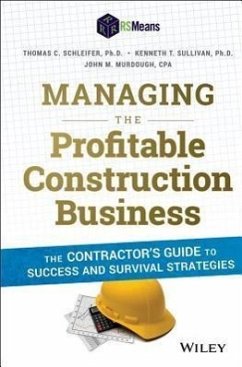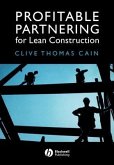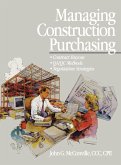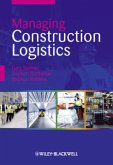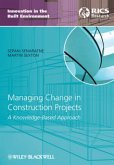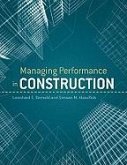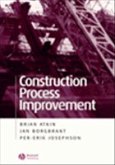Thomas C Schleifer, Kenneth T Sullivan, John M Murdough
Managing the Profitable Construction Business
The Contractor's Guide to Success and Survival Strategies
Thomas C Schleifer, Kenneth T Sullivan, John M Murdough
Managing the Profitable Construction Business
The Contractor's Guide to Success and Survival Strategies
- Gebundenes Buch
- Merkliste
- Auf die Merkliste
- Bewerten Bewerten
- Teilen
- Produkt teilen
- Produkterinnerung
- Produkterinnerung
Take control of your construction contracting business and manage it through the natural highs and lows of the construction market. Learn from a team of construction business veterans led by Thomas C. Schleifer, who is commonly referred to as a construction business "turnaround" expert due to the number of construction companies he has rescued from financial distress. His financial acumen, combined with his practical, hands-on experience, has made him a sought-after private consultant. His experience and no-nonsense philosophy have truly given him a unique perspective. Important topics covered…mehr
Andere Kunden interessierten sich auch für
![Profitable Partnering for Lean Construction Profitable Partnering for Lean Construction]() Clive Thomas CainProfitable Partnering for Lean Construction105,99 €
Clive Thomas CainProfitable Partnering for Lean Construction105,99 €![Managing Construction Purchasing Managing Construction Purchasing]() John G McConvilleManaging Construction Purchasing91,99 €
John G McConvilleManaging Construction Purchasing91,99 €![Managing Construction Logistics Managing Construction Logistics]() Gary SullivanManaging Construction Logistics90,99 €
Gary SullivanManaging Construction Logistics90,99 €![Managing Change in Construction Projects Managing Change in Construction Projects]() Sepani SenaratneManaging Change in Construction Projects136,99 €
Sepani SenaratneManaging Change in Construction Projects136,99 €![Managing Performance in Construction Managing Performance in Construction]() Leonhard E BernoldManaging Performance in Construction160,99 €
Leonhard E BernoldManaging Performance in Construction160,99 €![Project Partnering for the Design and Construction Industry Project Partnering for the Design and Construction Industry]() Ralph J StephensonProject Partnering for the Design and Construction Industry176,99 €
Ralph J StephensonProject Partnering for the Design and Construction Industry176,99 €![Construction Process Improvement Construction Process Improvement]() Brian Atkin / Jan Borgbrant / Per-Erik JosephsonConstruction Process Improvement143,99 €
Brian Atkin / Jan Borgbrant / Per-Erik JosephsonConstruction Process Improvement143,99 €-
-
-
Take control of your construction contracting business and manage it through the natural highs and lows of the construction market. Learn from a team of construction business veterans led by Thomas C. Schleifer, who is commonly referred to as a construction business "turnaround" expert due to the number of construction companies he has rescued from financial distress. His financial acumen, combined with his practical, hands-on experience, has made him a sought-after private consultant. His experience and no-nonsense philosophy have truly given him a unique perspective. Important topics covered include: * Understanding the primary areas of construction business failure in the next decade * Minimizing business risk with real-world examples * Developing a positive and competent management attitude and strategy Discover how to maneuver through this complicated and risky industry by using the authors' research and proven success strategies to sustain and grow your business.
Hinweis: Dieser Artikel kann nur an eine deutsche Lieferadresse ausgeliefert werden.
Hinweis: Dieser Artikel kann nur an eine deutsche Lieferadresse ausgeliefert werden.
Produktdetails
- Produktdetails
- Verlag: Wiley
- 2nd Revised edition
- Seitenzahl: 288
- Erscheinungstermin: 31. März 2014
- Englisch
- Abmessung: 236mm x 157mm x 20mm
- Gewicht: 522g
- ISBN-13: 9781118836941
- ISBN-10: 1118836944
- Artikelnr.: 39876269
- Herstellerkennzeichnung
- Libri GmbH
- Europaallee 1
- 36244 Bad Hersfeld
- gpsr@libri.de
- Verlag: Wiley
- 2nd Revised edition
- Seitenzahl: 288
- Erscheinungstermin: 31. März 2014
- Englisch
- Abmessung: 236mm x 157mm x 20mm
- Gewicht: 522g
- ISBN-13: 9781118836941
- ISBN-10: 1118836944
- Artikelnr.: 39876269
- Herstellerkennzeichnung
- Libri GmbH
- Europaallee 1
- 36244 Bad Hersfeld
- gpsr@libri.de
THOMAS C. SCHLEIFER, Ph.D. has 45 years of industry experience and was founder and President of the largest international consultancy firm serving the contract surety industry. He was an Eminent Scholar and Research Professor at the Del E. Webb School of Construction at Arizona State University. Dr. Schleifer, is known as "a turnaround" expert because of the number of companies that he has rescued from financial distress. KENNETH T. SULLIVAN, Ph.D. is an Associate Professor of Civil and Environmental Engineering at Arizona State University. He is Director of the Facility Management Research Institute and Co-Director of the Performance Based Studies Research Group. JOHN M. MURDOUGH, CPA is Principal of Pittman & Murdough, founded in 1989. Mr. Murdough is a well-known and respected construction accounting and business strategies specialist.
Foreword xiii
Preface xv
Acknowledgments xix
How to Use This Book xxi
Part 1 xxi
Part 2 xxi
A Teaching Text xxi
About the Authors xxiii
PART 1 1
1 Managing with Confidence 3
1.1 Lessons Learned 3
1.2 Objectives of This Book 4
1.3 Managing Areas of Risk 4
1.4 Recognizing Signs of Potential Trouble 5
1.5 Layers of Management 6
1.6 Owner versus Top Management 7
1.7 Disciplining Performance 7
1.8 Boards of Directors 8
1.9 Accountability 9
1.10 Selecting the Members 9
1.11 Importance of Credit 10
1.12 Volume versus Profit 11
1.13 Employee Benefits and Compensation 12
1.14 Borrowing 13
1.15 Business Planning 13
Chapter Review Questions 17
Critical Thinking and Discussion Questions 17
2 Elements of Contractor Failure 19
2.1 Capitalizing on Experience 19
2.2 Increase in Project Size 20
2.3 Unfamiliarity with New Geographic Areas 21
2.4 Moving into New Types of Construction 23
2.5 Changes in Key Personnel 26
2.6 Lack of Managerial Maturity in Expanding Organizations 28
Chapter Review Questions 29
Critical Thinking and Discussion Questions 30
3 Increase in Project Size 31
3.1 Limits of Growth 32
3.2 Increased Risks with Larger Projects 32
3.3 Case Study 33
3.4 Case Study Review 37
3.5 Underestimating the Size 37
3.6 Owners and Retainage 39
3.7 Allocating Time 39
3.8 Alternatives to Taking on Large Projects 39
3.9 Conclusion 41
Chapter Review Questions 41
Critical Thinking and Discussion Questions 42
4 Change in Geographic Location 43
4.1 Defining "Normal Area" 43
4.2 Reasons for Changing Geographic Area 43
4.3 Case Study: Long Distance Project 44
4.4 Review of the Long Distance Project Case Study 46
4.5 Managing the Risk with Long Distance Projects 47
4.6 Case Study: Regional Office 48
4.7 Review of the Regional Office Case Study 49
4.8 The Need for Personal Attention 50
4.9 Opening a Regional Office 50
4.10 Regional Office Contingency Plan 51
4.11 Conclusion 53
Chapter Review Questions 54
Critical Thinking and Discussion Questions 54
5 Changing or Adding to Type of Construction Performed 57
5.1 Reasons for Changes in Type of Work 57
5.2 Challenge: Lack of Experience 58
5.3 Challenge: Differences That Appear Subtle 60
5.4 Resolution: Know Your Specialty 60
5.5 Background to Case Studies 61
5.6 Case Study 1 61
5.7 Case Study 2 62
5.8 Example: Union versus Open Shop 64
5.9 Know the Risks 65
5.10 Volume versus Profit Alternative 65
5.11 Withdrawal Plan 66
5.12 Conclusion 67
Chapter Review Questions 67
Critical Thinking and Discussion Questions 68
6 Replace Key Personnel 69
6.1 Identifying Key People 69
6.2 Partners 70
6.3 Founders and Succession 71
6.4 Inactive Founders 72
6.5 Succession Case Study 72
6.6 New Management Team 75
6.7 Adding Key Personnel 75
6.8 Management "Dilution" 76
6.9 Summary 77
Chapter Review Questions 78
Critical Thinking and Discussion Questions 78
7 Managerial Maturity 81
7.1 Start-Up Construction Companies 81
7.2 Importance of Management Skills 82
7.3 Company Growth Phases 83
7.4 Limit of Managerial Effectiveness 84
7.5 Company Growth and Management Thresholds 85
7.6 Telltale Signs of Insufficient Managerial Maturity 85
7.7 The Challenge of Management Changes 86
7.8 Delegation of Authority 87
7.9 Test of Delegation 87
7.10 Managerial Maturity Case Study 88
7.11 Summary 90
Chapter Review Questions 91
Critical Thinking and Discussion Questions 92
8 Accounting Systems 93
8.1 Accounting and Information Management 93
8.2 Types of Systems 93
8.3 Who Is Responsible? 94
8.4 Accounts Payable 95
8.5 Disputed Invoices 96
8.6 Case Study 96
8.7 Recording Liabilities 98
8.8 Accounts Receivable 99
8.9 Timely Data Entry 99
8.10 Summary 100
Chapter Review Questions 101
Critical Thinking and Discussion Questions 101
9 Evaluating Contract Profitability 103
9.1 Measuring Performance 103
9.2 Accounting for Profit 104
9.3 Selection of Systems 105
9.4 Percentage of Completion 106
9.5 Estimated Profit 107
9.6 Case Study 107
9.7 Percentage of Completion Method of Accounting 108
9.8 Construction- Work In Progress Method 110
9.9 Over- and Underbilling 113
9.10 Impact of Total Revenue 114
9.11 Cost Control 116
9.12 Timeliness 116
9.13 Cost Control versus General Ledger 117
9.14 Tracking Costs 117
9.15 Working without Information 118
9.16 Summary 119
Chapter Review Questions 119
Critical Thinking and Discussion Questions 120
10 Equipment Cost Management 123
10.1 Ownership Costs 123
10.2 How Much to Own 123
10.3 Reasons to Buy 124
10.4 Competitive Position 124
10.5 Calculating Equipment Costs 125
10.6 Time and Usage 125
10.7 Replacement Costs 127
10.8 Equipment Costs Charged to Projects 127
10.9 Idle Equipment 128
10.10 Cash Flow 128
10.11 Equipment Obsolescence 129
10.12 Equipment Obsolescence Case Study 130
10.13 Replacement Cost Incurred Daily 131
10.14 Summary 133
Chapter Review Questions 133
Critical Thinking Questions 134
11 Other Industry Concerns 135
11.1 Introduction 135
11.2 Growth and Risk 135
11.3 Market Driven 136
11.4 Controlling the Need for Volume 136
11.5 Rate of Growth 137
11.6 Flexible Overhead 138
11.7 Mobility of the Industry 139
11.8 Diminished Profits 140
11.9 Employee Benefits and Compensation 140
11.10 Motivation and Loyalty 142
11.11 Internal Company Disputes 142
11.12 Debt 143
11.13 Business Planning 144
11.14 Recommendations 145
Chapter Review Questions 145
Critical Thinking and Discussion Questions 145
PART 2 147
12 Financial Management Issues 149
12.1 Keys to Success 150
12.2 What Financial Statement Are Supposed to Convey 150
12.3 Three Major Functions 151
12.4 Financial Statement Basics 152
12.5 Balance Sheet 153
12.6 The Holding Tank Concept 155
12.7 Assets 156
12.8 Current Assets 156
12.9 Property and Equipment 157
12.10 Other Assets 158
12.11 Liabilities 158
12.12 Equity 159
12.13 Income Statement 160
12.14 Financial Statement Sets 161
12.15 Summary 163
Chapter Review Questions 163
Critical Thinking and Discussion Questions 164
13 Financial Analysis and Indicators 167
13.1 Working Capital 168
13.2 Calculating Target Backlog 169
13.3 Calculating Target Annual Income 169
13.4 Maximizing Working Capital 169
13.5 Liquidity 171
13.6 Current Ratio 171
13.7 Quick Ratio 172
13.8 Receivables to Payables Ratio 172
13.9 Leverage 173
13.10 Financial Capacity 173
13.11 Additional Indicators 174
13.12 Break-Even Point 174
13.13 RScore 176
13.14 Change Percentages 177
13.15 Summary 177
Chapter Review Questions 179
Critical Thinking and Discussion Questions 180
14 Projection and Budgets 181
14.1 Terms 181
14.2 The Projection Process 182
14.3 The Pre-Projection Process 183
14.4 Key Operational Factors 184
14.5 The Projection Process 185
14.6 Putting the Projection to Use 191
14.7 Short-Term Cash Flow Projections 192
14.8 Summary 193
Chapter Review Questions 193
Critical Thinking and Discussion Questions 194
15 The Effective Use of Credit 195
15.1 Introduction 195
15.2 The Primary Creditors 195
15.3 Banking 196
15.4 Bonding 198
15.5 Leasing 200
15.6 Summary 202
Chapter Review Questions 203
Critical Thinking and Discussion Questions 204
16 Making Decisions in Volatile Conditions 205
16.1 The Effects of Market Cycles 205
16.2 G & A Stair-Steps 207
16.3 Using Cycles Positively 209
16.4 Consecutive Cycles and Fighting Tendencies 210
16.5 Summary 210
Chapter Review Questions 211
Critical Thinking and Discussion Questions 212
17 Success Factors for a Changing Industry 213
17.1 What a Client Wants 213
17.2 A Client Perspective of the Contract 215
17.3 How Contracts Are Awarded 217
17.4 How Contracts Are Won 218
17.5 Relationships and Contract Divergence 219
17.6 The Client's Vexing Problem 221
17.7 Goals of Alternative Delivery Methods 221
17.8 Successful RFP Response Strategies 224
17.9 Effectively Using Risk Analysis in a Proposal 225
17.10 How to Develop a Winning Proposal 230
17.11 Successful Interviewing Strategies 231
17.12 Summary 233
Chapter Review Questions 233
Critical Thinking and Discussion Questions 234
18 Performance Measurement 237
18.1 What to Measure 238
18.2 Setting the Client's Expectations 238
18.3 Risk-Based Preplanning 239
18.4 Measuring Project Performance 242
18.5 Measuring Past Performance 244
18.6 Performance-Based Client Relationships 244
18.7 Measurement and Leadership 245
18.8 Summary 248
Chapter Review Questions 248
Critical Thinking and Discussion Questions 249
Appendix: Answer Key for Chapter Review Questions 251
Index 253
Preface xv
Acknowledgments xix
How to Use This Book xxi
Part 1 xxi
Part 2 xxi
A Teaching Text xxi
About the Authors xxiii
PART 1 1
1 Managing with Confidence 3
1.1 Lessons Learned 3
1.2 Objectives of This Book 4
1.3 Managing Areas of Risk 4
1.4 Recognizing Signs of Potential Trouble 5
1.5 Layers of Management 6
1.6 Owner versus Top Management 7
1.7 Disciplining Performance 7
1.8 Boards of Directors 8
1.9 Accountability 9
1.10 Selecting the Members 9
1.11 Importance of Credit 10
1.12 Volume versus Profit 11
1.13 Employee Benefits and Compensation 12
1.14 Borrowing 13
1.15 Business Planning 13
Chapter Review Questions 17
Critical Thinking and Discussion Questions 17
2 Elements of Contractor Failure 19
2.1 Capitalizing on Experience 19
2.2 Increase in Project Size 20
2.3 Unfamiliarity with New Geographic Areas 21
2.4 Moving into New Types of Construction 23
2.5 Changes in Key Personnel 26
2.6 Lack of Managerial Maturity in Expanding Organizations 28
Chapter Review Questions 29
Critical Thinking and Discussion Questions 30
3 Increase in Project Size 31
3.1 Limits of Growth 32
3.2 Increased Risks with Larger Projects 32
3.3 Case Study 33
3.4 Case Study Review 37
3.5 Underestimating the Size 37
3.6 Owners and Retainage 39
3.7 Allocating Time 39
3.8 Alternatives to Taking on Large Projects 39
3.9 Conclusion 41
Chapter Review Questions 41
Critical Thinking and Discussion Questions 42
4 Change in Geographic Location 43
4.1 Defining "Normal Area" 43
4.2 Reasons for Changing Geographic Area 43
4.3 Case Study: Long Distance Project 44
4.4 Review of the Long Distance Project Case Study 46
4.5 Managing the Risk with Long Distance Projects 47
4.6 Case Study: Regional Office 48
4.7 Review of the Regional Office Case Study 49
4.8 The Need for Personal Attention 50
4.9 Opening a Regional Office 50
4.10 Regional Office Contingency Plan 51
4.11 Conclusion 53
Chapter Review Questions 54
Critical Thinking and Discussion Questions 54
5 Changing or Adding to Type of Construction Performed 57
5.1 Reasons for Changes in Type of Work 57
5.2 Challenge: Lack of Experience 58
5.3 Challenge: Differences That Appear Subtle 60
5.4 Resolution: Know Your Specialty 60
5.5 Background to Case Studies 61
5.6 Case Study 1 61
5.7 Case Study 2 62
5.8 Example: Union versus Open Shop 64
5.9 Know the Risks 65
5.10 Volume versus Profit Alternative 65
5.11 Withdrawal Plan 66
5.12 Conclusion 67
Chapter Review Questions 67
Critical Thinking and Discussion Questions 68
6 Replace Key Personnel 69
6.1 Identifying Key People 69
6.2 Partners 70
6.3 Founders and Succession 71
6.4 Inactive Founders 72
6.5 Succession Case Study 72
6.6 New Management Team 75
6.7 Adding Key Personnel 75
6.8 Management "Dilution" 76
6.9 Summary 77
Chapter Review Questions 78
Critical Thinking and Discussion Questions 78
7 Managerial Maturity 81
7.1 Start-Up Construction Companies 81
7.2 Importance of Management Skills 82
7.3 Company Growth Phases 83
7.4 Limit of Managerial Effectiveness 84
7.5 Company Growth and Management Thresholds 85
7.6 Telltale Signs of Insufficient Managerial Maturity 85
7.7 The Challenge of Management Changes 86
7.8 Delegation of Authority 87
7.9 Test of Delegation 87
7.10 Managerial Maturity Case Study 88
7.11 Summary 90
Chapter Review Questions 91
Critical Thinking and Discussion Questions 92
8 Accounting Systems 93
8.1 Accounting and Information Management 93
8.2 Types of Systems 93
8.3 Who Is Responsible? 94
8.4 Accounts Payable 95
8.5 Disputed Invoices 96
8.6 Case Study 96
8.7 Recording Liabilities 98
8.8 Accounts Receivable 99
8.9 Timely Data Entry 99
8.10 Summary 100
Chapter Review Questions 101
Critical Thinking and Discussion Questions 101
9 Evaluating Contract Profitability 103
9.1 Measuring Performance 103
9.2 Accounting for Profit 104
9.3 Selection of Systems 105
9.4 Percentage of Completion 106
9.5 Estimated Profit 107
9.6 Case Study 107
9.7 Percentage of Completion Method of Accounting 108
9.8 Construction- Work In Progress Method 110
9.9 Over- and Underbilling 113
9.10 Impact of Total Revenue 114
9.11 Cost Control 116
9.12 Timeliness 116
9.13 Cost Control versus General Ledger 117
9.14 Tracking Costs 117
9.15 Working without Information 118
9.16 Summary 119
Chapter Review Questions 119
Critical Thinking and Discussion Questions 120
10 Equipment Cost Management 123
10.1 Ownership Costs 123
10.2 How Much to Own 123
10.3 Reasons to Buy 124
10.4 Competitive Position 124
10.5 Calculating Equipment Costs 125
10.6 Time and Usage 125
10.7 Replacement Costs 127
10.8 Equipment Costs Charged to Projects 127
10.9 Idle Equipment 128
10.10 Cash Flow 128
10.11 Equipment Obsolescence 129
10.12 Equipment Obsolescence Case Study 130
10.13 Replacement Cost Incurred Daily 131
10.14 Summary 133
Chapter Review Questions 133
Critical Thinking Questions 134
11 Other Industry Concerns 135
11.1 Introduction 135
11.2 Growth and Risk 135
11.3 Market Driven 136
11.4 Controlling the Need for Volume 136
11.5 Rate of Growth 137
11.6 Flexible Overhead 138
11.7 Mobility of the Industry 139
11.8 Diminished Profits 140
11.9 Employee Benefits and Compensation 140
11.10 Motivation and Loyalty 142
11.11 Internal Company Disputes 142
11.12 Debt 143
11.13 Business Planning 144
11.14 Recommendations 145
Chapter Review Questions 145
Critical Thinking and Discussion Questions 145
PART 2 147
12 Financial Management Issues 149
12.1 Keys to Success 150
12.2 What Financial Statement Are Supposed to Convey 150
12.3 Three Major Functions 151
12.4 Financial Statement Basics 152
12.5 Balance Sheet 153
12.6 The Holding Tank Concept 155
12.7 Assets 156
12.8 Current Assets 156
12.9 Property and Equipment 157
12.10 Other Assets 158
12.11 Liabilities 158
12.12 Equity 159
12.13 Income Statement 160
12.14 Financial Statement Sets 161
12.15 Summary 163
Chapter Review Questions 163
Critical Thinking and Discussion Questions 164
13 Financial Analysis and Indicators 167
13.1 Working Capital 168
13.2 Calculating Target Backlog 169
13.3 Calculating Target Annual Income 169
13.4 Maximizing Working Capital 169
13.5 Liquidity 171
13.6 Current Ratio 171
13.7 Quick Ratio 172
13.8 Receivables to Payables Ratio 172
13.9 Leverage 173
13.10 Financial Capacity 173
13.11 Additional Indicators 174
13.12 Break-Even Point 174
13.13 RScore 176
13.14 Change Percentages 177
13.15 Summary 177
Chapter Review Questions 179
Critical Thinking and Discussion Questions 180
14 Projection and Budgets 181
14.1 Terms 181
14.2 The Projection Process 182
14.3 The Pre-Projection Process 183
14.4 Key Operational Factors 184
14.5 The Projection Process 185
14.6 Putting the Projection to Use 191
14.7 Short-Term Cash Flow Projections 192
14.8 Summary 193
Chapter Review Questions 193
Critical Thinking and Discussion Questions 194
15 The Effective Use of Credit 195
15.1 Introduction 195
15.2 The Primary Creditors 195
15.3 Banking 196
15.4 Bonding 198
15.5 Leasing 200
15.6 Summary 202
Chapter Review Questions 203
Critical Thinking and Discussion Questions 204
16 Making Decisions in Volatile Conditions 205
16.1 The Effects of Market Cycles 205
16.2 G & A Stair-Steps 207
16.3 Using Cycles Positively 209
16.4 Consecutive Cycles and Fighting Tendencies 210
16.5 Summary 210
Chapter Review Questions 211
Critical Thinking and Discussion Questions 212
17 Success Factors for a Changing Industry 213
17.1 What a Client Wants 213
17.2 A Client Perspective of the Contract 215
17.3 How Contracts Are Awarded 217
17.4 How Contracts Are Won 218
17.5 Relationships and Contract Divergence 219
17.6 The Client's Vexing Problem 221
17.7 Goals of Alternative Delivery Methods 221
17.8 Successful RFP Response Strategies 224
17.9 Effectively Using Risk Analysis in a Proposal 225
17.10 How to Develop a Winning Proposal 230
17.11 Successful Interviewing Strategies 231
17.12 Summary 233
Chapter Review Questions 233
Critical Thinking and Discussion Questions 234
18 Performance Measurement 237
18.1 What to Measure 238
18.2 Setting the Client's Expectations 238
18.3 Risk-Based Preplanning 239
18.4 Measuring Project Performance 242
18.5 Measuring Past Performance 244
18.6 Performance-Based Client Relationships 244
18.7 Measurement and Leadership 245
18.8 Summary 248
Chapter Review Questions 248
Critical Thinking and Discussion Questions 249
Appendix: Answer Key for Chapter Review Questions 251
Index 253
Foreword xiii
Preface xv
Acknowledgments xix
How to Use This Book xxi
Part 1 xxi
Part 2 xxi
A Teaching Text xxi
About the Authors xxiii
PART 1 1
1 Managing with Confidence 3
1.1 Lessons Learned 3
1.2 Objectives of This Book 4
1.3 Managing Areas of Risk 4
1.4 Recognizing Signs of Potential Trouble 5
1.5 Layers of Management 6
1.6 Owner versus Top Management 7
1.7 Disciplining Performance 7
1.8 Boards of Directors 8
1.9 Accountability 9
1.10 Selecting the Members 9
1.11 Importance of Credit 10
1.12 Volume versus Profit 11
1.13 Employee Benefits and Compensation 12
1.14 Borrowing 13
1.15 Business Planning 13
Chapter Review Questions 17
Critical Thinking and Discussion Questions 17
2 Elements of Contractor Failure 19
2.1 Capitalizing on Experience 19
2.2 Increase in Project Size 20
2.3 Unfamiliarity with New Geographic Areas 21
2.4 Moving into New Types of Construction 23
2.5 Changes in Key Personnel 26
2.6 Lack of Managerial Maturity in Expanding Organizations 28
Chapter Review Questions 29
Critical Thinking and Discussion Questions 30
3 Increase in Project Size 31
3.1 Limits of Growth 32
3.2 Increased Risks with Larger Projects 32
3.3 Case Study 33
3.4 Case Study Review 37
3.5 Underestimating the Size 37
3.6 Owners and Retainage 39
3.7 Allocating Time 39
3.8 Alternatives to Taking on Large Projects 39
3.9 Conclusion 41
Chapter Review Questions 41
Critical Thinking and Discussion Questions 42
4 Change in Geographic Location 43
4.1 Defining "Normal Area" 43
4.2 Reasons for Changing Geographic Area 43
4.3 Case Study: Long Distance Project 44
4.4 Review of the Long Distance Project Case Study 46
4.5 Managing the Risk with Long Distance Projects 47
4.6 Case Study: Regional Office 48
4.7 Review of the Regional Office Case Study 49
4.8 The Need for Personal Attention 50
4.9 Opening a Regional Office 50
4.10 Regional Office Contingency Plan 51
4.11 Conclusion 53
Chapter Review Questions 54
Critical Thinking and Discussion Questions 54
5 Changing or Adding to Type of Construction Performed 57
5.1 Reasons for Changes in Type of Work 57
5.2 Challenge: Lack of Experience 58
5.3 Challenge: Differences That Appear Subtle 60
5.4 Resolution: Know Your Specialty 60
5.5 Background to Case Studies 61
5.6 Case Study 1 61
5.7 Case Study 2 62
5.8 Example: Union versus Open Shop 64
5.9 Know the Risks 65
5.10 Volume versus Profit Alternative 65
5.11 Withdrawal Plan 66
5.12 Conclusion 67
Chapter Review Questions 67
Critical Thinking and Discussion Questions 68
6 Replace Key Personnel 69
6.1 Identifying Key People 69
6.2 Partners 70
6.3 Founders and Succession 71
6.4 Inactive Founders 72
6.5 Succession Case Study 72
6.6 New Management Team 75
6.7 Adding Key Personnel 75
6.8 Management "Dilution" 76
6.9 Summary 77
Chapter Review Questions 78
Critical Thinking and Discussion Questions 78
7 Managerial Maturity 81
7.1 Start-Up Construction Companies 81
7.2 Importance of Management Skills 82
7.3 Company Growth Phases 83
7.4 Limit of Managerial Effectiveness 84
7.5 Company Growth and Management Thresholds 85
7.6 Telltale Signs of Insufficient Managerial Maturity 85
7.7 The Challenge of Management Changes 86
7.8 Delegation of Authority 87
7.9 Test of Delegation 87
7.10 Managerial Maturity Case Study 88
7.11 Summary 90
Chapter Review Questions 91
Critical Thinking and Discussion Questions 92
8 Accounting Systems 93
8.1 Accounting and Information Management 93
8.2 Types of Systems 93
8.3 Who Is Responsible? 94
8.4 Accounts Payable 95
8.5 Disputed Invoices 96
8.6 Case Study 96
8.7 Recording Liabilities 98
8.8 Accounts Receivable 99
8.9 Timely Data Entry 99
8.10 Summary 100
Chapter Review Questions 101
Critical Thinking and Discussion Questions 101
9 Evaluating Contract Profitability 103
9.1 Measuring Performance 103
9.2 Accounting for Profit 104
9.3 Selection of Systems 105
9.4 Percentage of Completion 106
9.5 Estimated Profit 107
9.6 Case Study 107
9.7 Percentage of Completion Method of Accounting 108
9.8 Construction- Work In Progress Method 110
9.9 Over- and Underbilling 113
9.10 Impact of Total Revenue 114
9.11 Cost Control 116
9.12 Timeliness 116
9.13 Cost Control versus General Ledger 117
9.14 Tracking Costs 117
9.15 Working without Information 118
9.16 Summary 119
Chapter Review Questions 119
Critical Thinking and Discussion Questions 120
10 Equipment Cost Management 123
10.1 Ownership Costs 123
10.2 How Much to Own 123
10.3 Reasons to Buy 124
10.4 Competitive Position 124
10.5 Calculating Equipment Costs 125
10.6 Time and Usage 125
10.7 Replacement Costs 127
10.8 Equipment Costs Charged to Projects 127
10.9 Idle Equipment 128
10.10 Cash Flow 128
10.11 Equipment Obsolescence 129
10.12 Equipment Obsolescence Case Study 130
10.13 Replacement Cost Incurred Daily 131
10.14 Summary 133
Chapter Review Questions 133
Critical Thinking Questions 134
11 Other Industry Concerns 135
11.1 Introduction 135
11.2 Growth and Risk 135
11.3 Market Driven 136
11.4 Controlling the Need for Volume 136
11.5 Rate of Growth 137
11.6 Flexible Overhead 138
11.7 Mobility of the Industry 139
11.8 Diminished Profits 140
11.9 Employee Benefits and Compensation 140
11.10 Motivation and Loyalty 142
11.11 Internal Company Disputes 142
11.12 Debt 143
11.13 Business Planning 144
11.14 Recommendations 145
Chapter Review Questions 145
Critical Thinking and Discussion Questions 145
PART 2 147
12 Financial Management Issues 149
12.1 Keys to Success 150
12.2 What Financial Statement Are Supposed to Convey 150
12.3 Three Major Functions 151
12.4 Financial Statement Basics 152
12.5 Balance Sheet 153
12.6 The Holding Tank Concept 155
12.7 Assets 156
12.8 Current Assets 156
12.9 Property and Equipment 157
12.10 Other Assets 158
12.11 Liabilities 158
12.12 Equity 159
12.13 Income Statement 160
12.14 Financial Statement Sets 161
12.15 Summary 163
Chapter Review Questions 163
Critical Thinking and Discussion Questions 164
13 Financial Analysis and Indicators 167
13.1 Working Capital 168
13.2 Calculating Target Backlog 169
13.3 Calculating Target Annual Income 169
13.4 Maximizing Working Capital 169
13.5 Liquidity 171
13.6 Current Ratio 171
13.7 Quick Ratio 172
13.8 Receivables to Payables Ratio 172
13.9 Leverage 173
13.10 Financial Capacity 173
13.11 Additional Indicators 174
13.12 Break-Even Point 174
13.13 RScore 176
13.14 Change Percentages 177
13.15 Summary 177
Chapter Review Questions 179
Critical Thinking and Discussion Questions 180
14 Projection and Budgets 181
14.1 Terms 181
14.2 The Projection Process 182
14.3 The Pre-Projection Process 183
14.4 Key Operational Factors 184
14.5 The Projection Process 185
14.6 Putting the Projection to Use 191
14.7 Short-Term Cash Flow Projections 192
14.8 Summary 193
Chapter Review Questions 193
Critical Thinking and Discussion Questions 194
15 The Effective Use of Credit 195
15.1 Introduction 195
15.2 The Primary Creditors 195
15.3 Banking 196
15.4 Bonding 198
15.5 Leasing 200
15.6 Summary 202
Chapter Review Questions 203
Critical Thinking and Discussion Questions 204
16 Making Decisions in Volatile Conditions 205
16.1 The Effects of Market Cycles 205
16.2 G & A Stair-Steps 207
16.3 Using Cycles Positively 209
16.4 Consecutive Cycles and Fighting Tendencies 210
16.5 Summary 210
Chapter Review Questions 211
Critical Thinking and Discussion Questions 212
17 Success Factors for a Changing Industry 213
17.1 What a Client Wants 213
17.2 A Client Perspective of the Contract 215
17.3 How Contracts Are Awarded 217
17.4 How Contracts Are Won 218
17.5 Relationships and Contract Divergence 219
17.6 The Client's Vexing Problem 221
17.7 Goals of Alternative Delivery Methods 221
17.8 Successful RFP Response Strategies 224
17.9 Effectively Using Risk Analysis in a Proposal 225
17.10 How to Develop a Winning Proposal 230
17.11 Successful Interviewing Strategies 231
17.12 Summary 233
Chapter Review Questions 233
Critical Thinking and Discussion Questions 234
18 Performance Measurement 237
18.1 What to Measure 238
18.2 Setting the Client's Expectations 238
18.3 Risk-Based Preplanning 239
18.4 Measuring Project Performance 242
18.5 Measuring Past Performance 244
18.6 Performance-Based Client Relationships 244
18.7 Measurement and Leadership 245
18.8 Summary 248
Chapter Review Questions 248
Critical Thinking and Discussion Questions 249
Appendix: Answer Key for Chapter Review Questions 251
Index 253
Preface xv
Acknowledgments xix
How to Use This Book xxi
Part 1 xxi
Part 2 xxi
A Teaching Text xxi
About the Authors xxiii
PART 1 1
1 Managing with Confidence 3
1.1 Lessons Learned 3
1.2 Objectives of This Book 4
1.3 Managing Areas of Risk 4
1.4 Recognizing Signs of Potential Trouble 5
1.5 Layers of Management 6
1.6 Owner versus Top Management 7
1.7 Disciplining Performance 7
1.8 Boards of Directors 8
1.9 Accountability 9
1.10 Selecting the Members 9
1.11 Importance of Credit 10
1.12 Volume versus Profit 11
1.13 Employee Benefits and Compensation 12
1.14 Borrowing 13
1.15 Business Planning 13
Chapter Review Questions 17
Critical Thinking and Discussion Questions 17
2 Elements of Contractor Failure 19
2.1 Capitalizing on Experience 19
2.2 Increase in Project Size 20
2.3 Unfamiliarity with New Geographic Areas 21
2.4 Moving into New Types of Construction 23
2.5 Changes in Key Personnel 26
2.6 Lack of Managerial Maturity in Expanding Organizations 28
Chapter Review Questions 29
Critical Thinking and Discussion Questions 30
3 Increase in Project Size 31
3.1 Limits of Growth 32
3.2 Increased Risks with Larger Projects 32
3.3 Case Study 33
3.4 Case Study Review 37
3.5 Underestimating the Size 37
3.6 Owners and Retainage 39
3.7 Allocating Time 39
3.8 Alternatives to Taking on Large Projects 39
3.9 Conclusion 41
Chapter Review Questions 41
Critical Thinking and Discussion Questions 42
4 Change in Geographic Location 43
4.1 Defining "Normal Area" 43
4.2 Reasons for Changing Geographic Area 43
4.3 Case Study: Long Distance Project 44
4.4 Review of the Long Distance Project Case Study 46
4.5 Managing the Risk with Long Distance Projects 47
4.6 Case Study: Regional Office 48
4.7 Review of the Regional Office Case Study 49
4.8 The Need for Personal Attention 50
4.9 Opening a Regional Office 50
4.10 Regional Office Contingency Plan 51
4.11 Conclusion 53
Chapter Review Questions 54
Critical Thinking and Discussion Questions 54
5 Changing or Adding to Type of Construction Performed 57
5.1 Reasons for Changes in Type of Work 57
5.2 Challenge: Lack of Experience 58
5.3 Challenge: Differences That Appear Subtle 60
5.4 Resolution: Know Your Specialty 60
5.5 Background to Case Studies 61
5.6 Case Study 1 61
5.7 Case Study 2 62
5.8 Example: Union versus Open Shop 64
5.9 Know the Risks 65
5.10 Volume versus Profit Alternative 65
5.11 Withdrawal Plan 66
5.12 Conclusion 67
Chapter Review Questions 67
Critical Thinking and Discussion Questions 68
6 Replace Key Personnel 69
6.1 Identifying Key People 69
6.2 Partners 70
6.3 Founders and Succession 71
6.4 Inactive Founders 72
6.5 Succession Case Study 72
6.6 New Management Team 75
6.7 Adding Key Personnel 75
6.8 Management "Dilution" 76
6.9 Summary 77
Chapter Review Questions 78
Critical Thinking and Discussion Questions 78
7 Managerial Maturity 81
7.1 Start-Up Construction Companies 81
7.2 Importance of Management Skills 82
7.3 Company Growth Phases 83
7.4 Limit of Managerial Effectiveness 84
7.5 Company Growth and Management Thresholds 85
7.6 Telltale Signs of Insufficient Managerial Maturity 85
7.7 The Challenge of Management Changes 86
7.8 Delegation of Authority 87
7.9 Test of Delegation 87
7.10 Managerial Maturity Case Study 88
7.11 Summary 90
Chapter Review Questions 91
Critical Thinking and Discussion Questions 92
8 Accounting Systems 93
8.1 Accounting and Information Management 93
8.2 Types of Systems 93
8.3 Who Is Responsible? 94
8.4 Accounts Payable 95
8.5 Disputed Invoices 96
8.6 Case Study 96
8.7 Recording Liabilities 98
8.8 Accounts Receivable 99
8.9 Timely Data Entry 99
8.10 Summary 100
Chapter Review Questions 101
Critical Thinking and Discussion Questions 101
9 Evaluating Contract Profitability 103
9.1 Measuring Performance 103
9.2 Accounting for Profit 104
9.3 Selection of Systems 105
9.4 Percentage of Completion 106
9.5 Estimated Profit 107
9.6 Case Study 107
9.7 Percentage of Completion Method of Accounting 108
9.8 Construction- Work In Progress Method 110
9.9 Over- and Underbilling 113
9.10 Impact of Total Revenue 114
9.11 Cost Control 116
9.12 Timeliness 116
9.13 Cost Control versus General Ledger 117
9.14 Tracking Costs 117
9.15 Working without Information 118
9.16 Summary 119
Chapter Review Questions 119
Critical Thinking and Discussion Questions 120
10 Equipment Cost Management 123
10.1 Ownership Costs 123
10.2 How Much to Own 123
10.3 Reasons to Buy 124
10.4 Competitive Position 124
10.5 Calculating Equipment Costs 125
10.6 Time and Usage 125
10.7 Replacement Costs 127
10.8 Equipment Costs Charged to Projects 127
10.9 Idle Equipment 128
10.10 Cash Flow 128
10.11 Equipment Obsolescence 129
10.12 Equipment Obsolescence Case Study 130
10.13 Replacement Cost Incurred Daily 131
10.14 Summary 133
Chapter Review Questions 133
Critical Thinking Questions 134
11 Other Industry Concerns 135
11.1 Introduction 135
11.2 Growth and Risk 135
11.3 Market Driven 136
11.4 Controlling the Need for Volume 136
11.5 Rate of Growth 137
11.6 Flexible Overhead 138
11.7 Mobility of the Industry 139
11.8 Diminished Profits 140
11.9 Employee Benefits and Compensation 140
11.10 Motivation and Loyalty 142
11.11 Internal Company Disputes 142
11.12 Debt 143
11.13 Business Planning 144
11.14 Recommendations 145
Chapter Review Questions 145
Critical Thinking and Discussion Questions 145
PART 2 147
12 Financial Management Issues 149
12.1 Keys to Success 150
12.2 What Financial Statement Are Supposed to Convey 150
12.3 Three Major Functions 151
12.4 Financial Statement Basics 152
12.5 Balance Sheet 153
12.6 The Holding Tank Concept 155
12.7 Assets 156
12.8 Current Assets 156
12.9 Property and Equipment 157
12.10 Other Assets 158
12.11 Liabilities 158
12.12 Equity 159
12.13 Income Statement 160
12.14 Financial Statement Sets 161
12.15 Summary 163
Chapter Review Questions 163
Critical Thinking and Discussion Questions 164
13 Financial Analysis and Indicators 167
13.1 Working Capital 168
13.2 Calculating Target Backlog 169
13.3 Calculating Target Annual Income 169
13.4 Maximizing Working Capital 169
13.5 Liquidity 171
13.6 Current Ratio 171
13.7 Quick Ratio 172
13.8 Receivables to Payables Ratio 172
13.9 Leverage 173
13.10 Financial Capacity 173
13.11 Additional Indicators 174
13.12 Break-Even Point 174
13.13 RScore 176
13.14 Change Percentages 177
13.15 Summary 177
Chapter Review Questions 179
Critical Thinking and Discussion Questions 180
14 Projection and Budgets 181
14.1 Terms 181
14.2 The Projection Process 182
14.3 The Pre-Projection Process 183
14.4 Key Operational Factors 184
14.5 The Projection Process 185
14.6 Putting the Projection to Use 191
14.7 Short-Term Cash Flow Projections 192
14.8 Summary 193
Chapter Review Questions 193
Critical Thinking and Discussion Questions 194
15 The Effective Use of Credit 195
15.1 Introduction 195
15.2 The Primary Creditors 195
15.3 Banking 196
15.4 Bonding 198
15.5 Leasing 200
15.6 Summary 202
Chapter Review Questions 203
Critical Thinking and Discussion Questions 204
16 Making Decisions in Volatile Conditions 205
16.1 The Effects of Market Cycles 205
16.2 G & A Stair-Steps 207
16.3 Using Cycles Positively 209
16.4 Consecutive Cycles and Fighting Tendencies 210
16.5 Summary 210
Chapter Review Questions 211
Critical Thinking and Discussion Questions 212
17 Success Factors for a Changing Industry 213
17.1 What a Client Wants 213
17.2 A Client Perspective of the Contract 215
17.3 How Contracts Are Awarded 217
17.4 How Contracts Are Won 218
17.5 Relationships and Contract Divergence 219
17.6 The Client's Vexing Problem 221
17.7 Goals of Alternative Delivery Methods 221
17.8 Successful RFP Response Strategies 224
17.9 Effectively Using Risk Analysis in a Proposal 225
17.10 How to Develop a Winning Proposal 230
17.11 Successful Interviewing Strategies 231
17.12 Summary 233
Chapter Review Questions 233
Critical Thinking and Discussion Questions 234
18 Performance Measurement 237
18.1 What to Measure 238
18.2 Setting the Client's Expectations 238
18.3 Risk-Based Preplanning 239
18.4 Measuring Project Performance 242
18.5 Measuring Past Performance 244
18.6 Performance-Based Client Relationships 244
18.7 Measurement and Leadership 245
18.8 Summary 248
Chapter Review Questions 248
Critical Thinking and Discussion Questions 249
Appendix: Answer Key for Chapter Review Questions 251
Index 253

